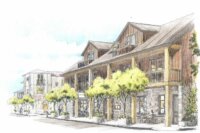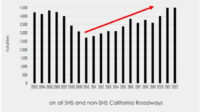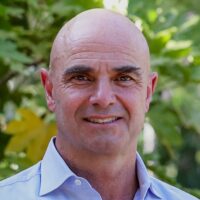A proposal to build a free hospital in Sonoma didn’t get a free ride at a public forum Monday night.
Audience members asked tough questions of the developers who want to build a privately funded hospital to replace the publicly owned Sonoma Valley Hospital, which faces potential closure in 2013 under state earthquake-safety laws. And not all of them accepted the answers.
At first blush, you might wonder what’s not to like about the private hospital, accompanying medical office building and luxury health spa that are proposed for the northwest corner of Eighth Street East and Napa Road.
The hospital wouldn’t cost taxpayers a dime. It would have a full-service emergency room open around the clock that would accept all patients. It would pay sales taxes and property taxes back to the community — unlike the public hospital, which pays no taxes.
Those were some highlights presented by John Thomas, president of the Dallas, Texas-based Cirrus Health, which proposes to build and operate the hospital, and architect Michael Ross, of the Boyes Hot Springs-based firm Ross Drulis Cusenbury, which would design the luxury spa.
“The total public tax financing that’s being presented to you in this proposal tonight is… zero,” Ross said to an audience of about 80 people gathered at the Vintage House Senior Center for the Monday night meeting of the Sonoma Valley Health Care Coalition. It’s an ad hoc group that’s trying to ensure that the Sonoma Valley maintains some sort of hospital following the failure in the spring of Measure C, a $148 million ballot proposal to replace the existing Andrieux Street facility.
Thomas and Ross said that the privately funded hospital would make its money by drawing customers from the greater Bay Area — and the entire nation — for specialty treatments such as bariatric, or weight-loss surgery, joint replacements and “executive physicals,” 5-day stays at which wealthy patients with cardiac problems or other illnesses would dwell in one of 60 cabins at a luxury health spa that’s proposed on the property next to the hospital by Sonoma developer Henry Grause, who also took the microphone and spoke at Monday’s meeting.
The spa’s guests would learn exercise habits in the spa’s pool and other facilities and healthful cooking skills at such places as Ramekins Culinary School.
Services guaranteed?
Audience members didn’t pull any punches, once the presentation ended and the question-and-answer period began.
The current hospital’s administrators have said all along that some hospital operations, such as the emergency room, are money-losers.
The first audience question came from coalition spokesman Bob Edwards, who wanted to know if Cirrus Health was willing to sign “legally binding” documents promising to provide the services that the public hospital now offers.
And Steve Page, general manager of Infineon Raceway and a leader in the pro-Measure C campaign, sought assurances that the private hospital would provide basic services to the community, even if such services weren’t profitable.
Page framed the private hospital proposal as a trade: Sonoma voters would have to approve an expansion of the urban growth boundary to allow public utilities, mainly water and sewer service, to reach the Eighth Street East site, which currently is outside the city limits.
That would allow the developers to open their medical spa, with the hospital and medical office building thrown in to sweeten the deal for the public.
But Page said that if the hospital’s earnings took a nosedive, its investors would apply pressure to cut unprofitable services — as would happen in any business.
“Fifteen, 20, years from now… how do we assure that the memory of that deal doesn’t fade?” Page asked.
In response, Thomas offered to sit down with attorneys to work out a solution. Thomas also addressed the larger issue of private hospitals versus public hospitals.
Communities have concerns when private firms take over, he said.
But Thomas said that private hospitals are successful, including in his home state of Texas where more than half of the hospitals are privately owned.
Enough customers?
Robert Kowal, the Sonoma Valley Hospital’s chief executive officer, questioned Cirrus Health’s business model, saying that Cirrus planned on having 90 percent of its income come through surgery. Kowal said that, now, surgery only makes up a small percentage of the Sonoma Valley Hospital’s business. Currently, 83 percent of the hospital’s clientele are medical patients, such as people in their 80s who need non-surgical treatment for such things as congestive heart failure, he said.
“This isn’t razzle-dazzle medicine. It doesn’t pay well. I don’t see how your model can work,” Kowal said. “Our facility is just the exact opposite of what you’re talking about.”
Thomas responded by saying the proposed Cirrus Health facility would attract surgical business. At one point during his presentation, Thomas showed a satellite map of all the other hospitals, doctors and health facilities within a 30-mile radius of the Sonoma Valley — a market that he said could be tapped by the Cirrus Health facility and associated medical spa.
“This is $1.5 billion in hospital revenue, (some) of which could be brought to this community,” Thomas said.
Thomas predicted that the new hospital would cost $50 million to $60 million. The capital for that would come from Cirrus Group, the real estate development sister company of Cirrus Health.
Cirrus Health is hoping to find at least 50 physicians who would each invest $200,000 in the hospital, or a total of $10 million.
The physicians would own the hospital business and rent space in the building.
John MacConaghy, a Sonoma attorney and elected member of the current hospital’s governing board, questioned whether the hospital would be able to attract enough business to produce the $6 million to $8 million in annual revenue that McConaghy estimated would be needed to cover the capital costs of the hospital’s construction.
Thomas said, “We believe the market’s out there to do that.” He said that Cirrus Health is working on an in-depth feasibility analysis that should be done by the end of October.
Thomas said that Cirrus Health invited two dozen doctors to a dinner two weeks ago and the physicians had “high interest” in the proposed private hospital. Throughout the evening, Thomas defended the idea of physician-owned hospitals, saying that federal studies have shown that such facilities provide superior medical care.
Cirrus Health currently operates specialty surgical centers. Kowal said those only work if a full-service hospital is nearby. One woman in the audience suggested that “Sonoma will be an experiment” for Cirrus Health, because the proposed hospital here would be its first full-service facility.
Thomas responded, “We’re going to invest $50 million. It won’t be an experiment.”
An audience member asked what would happen if the proposed Cirrus hospital failed.
Grause said, in that case, the community could buy the hospital from Cirrus.
“This community is going to buy one hell of a hospital really cheap,” Grause told the audience.
If the community supports the Cirrus hospital proposal and amends the urban growth boundary to incorporate the site into city limits, Thomas predicted the new hospital could be built by March, 2011.
“In California, that’s a very quick (construction) for a hospital,” he said.
Architect Michael Ross said that the Cirrus hospital proposal calls for freezing the existing zoning in place on the land that would be added to the city of Sonoma.
“Therefore, it will not be sprawl-inducing or growth-inducing,” Ross said.
The Sonoma Valley Health Care Coalition won’t meet again until Monday, Sept. 25, when David Goodison, Sonoma’s city planner, and Valerie Brown, the Sonoma County Supervisor who represents the Valley, will speak about the urban growth boundary and other hospital siting issues at 7 p.m. at the Vintage House senior center.




